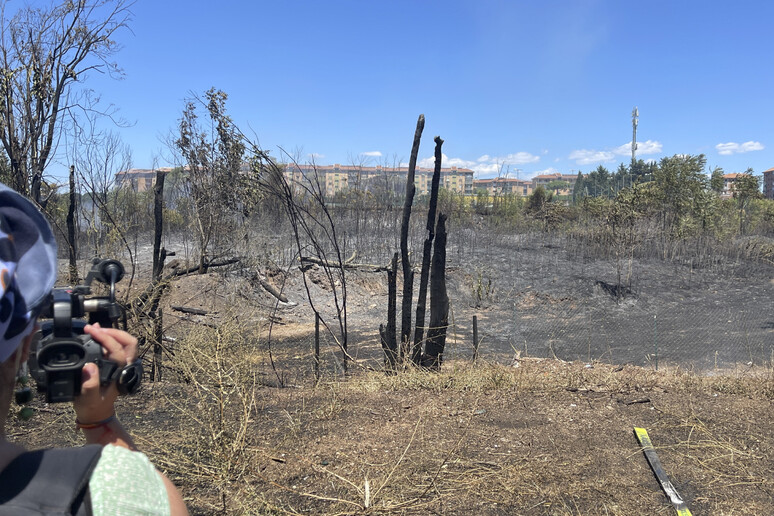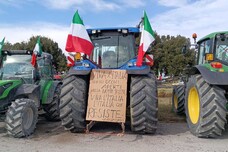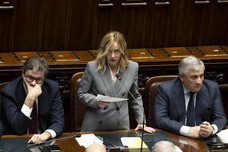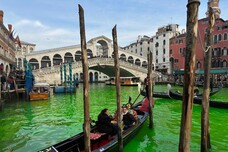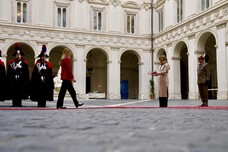by enr-correspondents May 30 marks the start of the wildfire season in the EU. European Commissioner for Crisis Management Janez Lenarčič spoke to the enr about crisis response, climate change and the 10th birthday of the Emergency Response Coordination Centre (ERCC).
One Direction.
The summer of 2022 was the hottest summer on record in Europe.
It also saw the second worst wildfire season since records are kept, "in the number of fires as well as in the number of area burned," Janez Lenarčič, the Slovenian Commissioner in charge of civil protection and humanitarian aid, said in an interview with journalists of the European Newsroom (enr) on Thursday. "The longer term trends unmistakably point to one direction: We are going to face more of this." Dry weather in combination with heat is a major driver of forest fires. "We expect a busy, busy summer - this year has already started much drier than average," the Slovenian politician explained, pointing to the "very recent" situation in Portugal, Spain, France and Germany, which had called for fire-fighting aid last year. The record temperatures of 2022 also contributed to record-low water levels of European rivers and lakes, in turn impacting other sectors such as transport or energy, the former Slovenian state secretary said.
The past experiences in combination with scientific forecasts of natural disasters were among the key reasons to increase firefighting capacities within the European Union. "On May 30, we will mark the 10th anniversary of the Emergency Response Coordination Centre and its operations," the commissioner said.
Contracts will also be distributed to member states who will host the increased capacity of the aerial firefighting fleet.
Hope does not constitute good preparedness - Lenarčič.
Putting in place measures to prevent fires was becoming more and more important. Especially since the fire season starts earlier and lasts longer than previously - and an "overwhelming majority of wildfires" are caused by human actions, the Slovenian politician stated.
Fires were no longer "confined to the south-eastern part of Europe and the Mediterranean region," the commissioner added.
This called for further efforts in response capacities but also in prevention, which was embodied in the Wildfire Prevention Action Plan that included initiatives and recommendations, Lenarčič said. Even though nothing "can be imposed on member states because this is their own national competence." "Disasters know no borders": Crisis Management in the EU and beyond.
The ERCC is the crisis management hub of the European Commission, the body coordinating emergency response of the EU and its member states - and the engine behind the European Civil Protection Mechanism, which was established in 2001.
It tackles man-made disasters such as war, natural disasters such as pandemics, floods, earthquakes and fires, but also works strategically on areas of chemical, biological, radiological and nuclear preparedness, as well as logistics, transport, shelter and energy, among others.
Lenarčič stated that the ERCC had been "quite busy" since the start of the current Commission's mandate in 2019. This was due to the Covid-19-pandemic as well as the Russian invasion of Ukraine, but also the "increased frequency and intensity of various weather-related events which show that we are already deep into the climate crisis," he explained, adding that "there are changes that are already irreversible", which needed to be mitigated.
"We are in a new normal and this calls for action in all stages of the crisis management cycle, not just in response, but also in particular on prevention and preparedness," said Lenarčič.
He explained that while according to the legal basis, civil protection was a responsibility of the member states, where the commission played a supportive role, the increased frequency and intensity of natural disasters could "overwhelm the capacities of individual member states." Over the past two decades, the Union Civil Protection Mechanism had been "activated on average 20 times per year, meaning once or twice per month," Lenarčič explained. However, there had been a steep increase: Since the beginning of the current Commission's mandate, the mechanism had been activated "more than 100 times each year," with an average of "one to two [activations] each week." Requests for assistance from a country are counted with regard to one specific crisis or disaster. "In this sense, the request from Ukraine - because of the crisis caused by the Russian invasion - counts as one," the crisis management commissioner said, adding that "in reality, since the start of the Russian invasion, we have had more than 120 requests or updated requests just from Ukraine." Countries asking for help do not need to be members of the European Union, countries such as Syria and Chile have asked for help in the past.
"Any country can ask for assistance from the Union's Civil Protection Mechanism - and they do so," said Lenarčič.
While Lenarčič said that in 2023, no country had asked for forest fire assistance yet, the fire-fighting capacities at EU level had been increased in preparation for the upcoming fire season from 13 aircraft in 2022: "We will have ten medium amphibious aeroplanes, 14 light amphibious aeroplanes and four medium and heavy helicopters," the commissioner explained, adding that the water caption capacity of the fleet roughly doubled.
It's not cheap, but necessary.
With the increased number of activations of the mechanism and incidences of help needed, as well as the anticipated increase in frequency and intensity of weather-related disasters, Lenarčič added that the financial resources were "basically the same" as planned when the current Multiannual Financial Framework (MFF) was proposed in 2018 by the Juncker Commission, before the pandemic or the Russian invasion of Ukraine.
The EU budget for civil protection amounted to "about 1.2 billion euros for the entire seven-year-period and is not adequate in view of the challenges that we face," Lenarčič said.
Further EU funding "worth about 2 billion euros was allocated in addition", primarily in response to the pandemic and to increase resilience and preparedness for future pandemics.
"Every year, we need about 75 million euros of reinforcements.
This shows that we will need to place European civil protection on a more solid financial basis, because we already cannot go through a year without reinforcements." "We get reinforcements when we need them. But this is not a very sound basis for the full operation," Lenarčič.
"Global warming is a fact. Its negative impact on climate is a fact. One of the symptoms of this is the increased frequency and intensity of extreme weather-related events. So, there is a need to act," Lenarčič remarked, stating the need to "rely on science" when it came to dealing with those who doubted the reality of climate change.
"The green transition will not be cheap. It will cost, it will require investments. But it's important to be aware of the following: If we don't do it, the cost will be much higher for everyone," the commissioner said, adding that the Just Transition Fund was to ensure that the transition did not "disproportionately burden" those most vulnerable.
When disaster strikes: Response, prevention, preparedness, resilience.
Underlining that efforts in the field of preparedness had to be strengthened, Lenarčič explained the recent launch of the so-called Disaster Resilience Goals as a "form of recommendations to EU member states." Currently, member states work on their implementation, which is facilitated through an initiative for each Disaster Resilience Goal.
"These goals are to anticipate better, then to prepare better, to alert in the sense of improving early warning systems, then to respond. When disaster strikes, you have to organise a response. And finally, to secure the operational status and effectiveness of crisis response mechanisms," Lenarčič said
This content is based on news from agencies participating in the enr.
ALL RIGHTS RESERVED © Copyright ANSA
